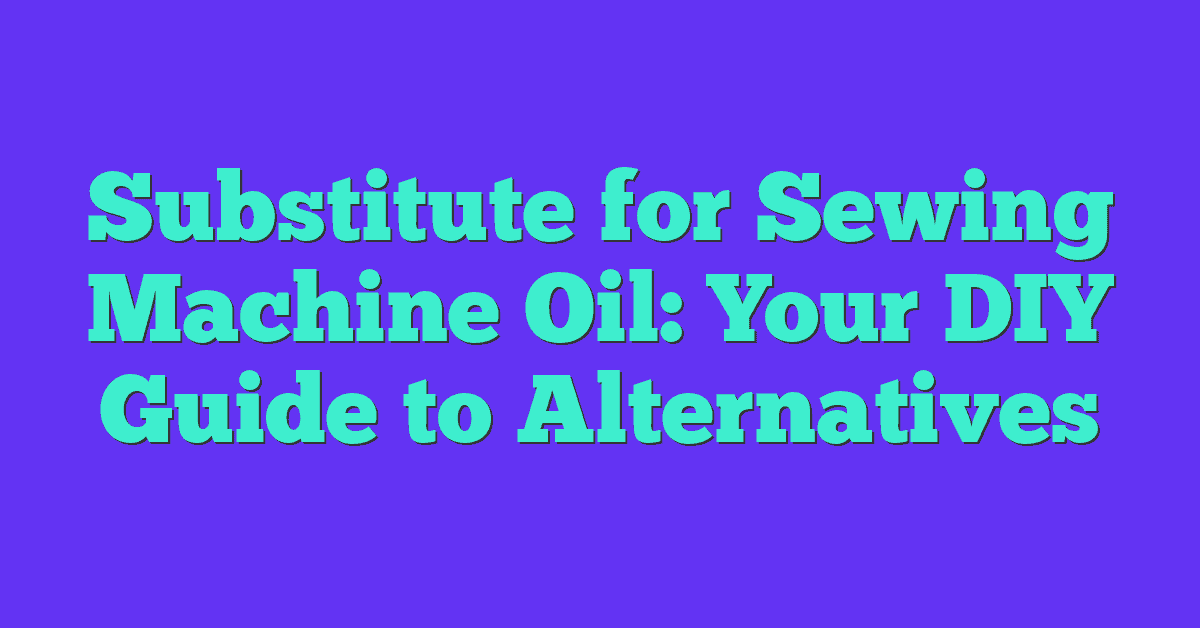Oh no! Your sewing machine just screeched to a halt mid-stitch, and you’re fresh out of sewing machine oil. Don’t fret, my crafty friend! There are several reliable substitutes that can get your favorite tool humming again in no time.
Just think of it: household items like petroleum jelly or even hair clipper oil could act as a temporary solution for your sticky situation. But bear in mind, these are not long-term fixes – they’re just here to save the day when you’ve run out of the real thing and the stores have closed.
While these might seem like unusual suggestions, trust me on this one — they work! But remember, always use them sparingly and only when necessary to prevent potential damage to your precious machine. As always, using genuine sewing machine oil is highly recommended whenever possible for optimal performance.
Understanding the Importance of Sewing Machine Oil
Here’s something you might’ve overlooked – the significance of sewing machine oil. It’s a crucial element that keeps your sewing machine humming along smoothly. You see, like any other mechanical device, your sewing machine needs lubrication to function optimally and prevent damage.
Just imagine what happens when you neglect oiling your car engine. The friction builds up, parts begin to wear out quicker and before you know it, there’s smoke billowing out from under the hood! Well, your sewing machine isn’t too different. Without proper lubrication, components can start grinding against each other causing unnecessary wear and tear.
Now let’s think about how this affects you directly. If you’re into sewing – whether as a hobby or professionally – a well-oiled machine means fewer interruptions during work. It ensures smooth operation with less noise and prevents thread snags or breakage which can be quite annoying mid-project.
Moreover, regular use of quality sewing machine oil extends the lifespan of your equipment saving you costly repairs or replacements in the long run. Imagine all those extra years of creative projects because you took a couple minutes every so often to maintain your tool!
So yeah! That little bottle of oil is more important than it seems at first glance. Not only does it keep things running smoothly but also saves money in the long run by reducing chances for major breakdowns.
Common Types of Sewing Machine Oils
Wondering what kind of oil is best for your sewing machine? Let’s dive into some common types that might just do the trick.
First off, we’ve got White Mineral Oil. This one’s a crowd favorite because it’s colorless and odorless. It also doesn’t stain your fabric – a big plus if you’re working with light-colored materials. Another perk? It’s highly refined to remove any impurities which could damage your machine.
Next up, let’s tackle Tri-Flow Superior Lubricant. Now, this isn’t exclusively for sewing machines but its synthetic formula works wonders on them! Why? Because it contains micro particles known as PTFE (or Teflon) which drastically reduces friction and wear on your precious equipment.
Then there’s Zoom Spout Oiler – a nifty choice that packs quite a punch despite its small size. Its standout feature is the flexible spout which allows precise application even in hard-to-reach areas of your sewing machine.
Let’s not forget Liberty Oil, another synthetic option that promises smooth operation thanks to its thin consistency and high lubricity properties (aka slipperiness). Not only does it protect against rust and corrosion, but also boasts an anti-wear additive that extends the life of metal parts within your machine.
And finally, Juki Defrix Oil No.1 takes a bow as an excellent choice specifically made by Juki Corporation for their industrial sewing machines – talk about keeping things in the family!

So there you have it! From mineral oils to synthetics, each type comes with its own perks and potential drawbacks so consider what suits YOUR needs best before making a decision.
Why You Might Need a Substitute for Sewing Machine Oil
Imagine being in the middle of a crucial project, sewing away, and your machine starts coughing up. It’s crying out for oil but you’ve just run out! That’s one of the key moments when you might need a substitute for sewing machine oil.
While it’s recommended to use specialized sewing machine oil where possible, sometimes life happens and you’re caught without any on hand. This could be due to delays in delivery or simply forgetting to restock. But don’t fret, as there are options available that can help tide you over until you get your hands on some proper sewing machine oil.
So what can be used as a quick fix? Well-known substitutes include household items like petroleum jelly, WD-40, or even clear cooking oils like canola or coconut oil. Now remember: these are not long-term solutions but they’ll do in a pinch! They should provide enough lubrication to keep your machine running smoothly until the real deal arrives.
Of course, using substitutes isn’t just restricted to emergency situations. Maybe you’re aiming towards more environmentally friendly practices and want an eco-friendly alternative to traditional sewing machine oils? In this case, natural oils such as jojoba or silicone spray could be right up your alley.
« Types of Sewing Scissors: Your Essential Guide to Finding the Perfect Pair
Sewing Facts: Your Essential Guide to the World of Stitching »
Lastly, maybe it’s not about necessity at all but curiosity instead! Perhaps you’ve heard tales of unusual alternatives providing unique benefits? From extending machinery lifespan with car engine oil to enhancing performance with hair clipper oil, there are plenty of experiments waiting for adventurous sewers!
So whether it’s out of necessity, environmentalism or curiosity – there may come a time when you require a substitute for regular sewing machine oil. And when that happens… well now YOU’RE PREPARED!
Safe and Effective Alternatives to Traditional Sewing Machine Oil
You’re in the middle of a sewing project when you suddenly realize – you’re out of sewing machine oil! Don’t worry, there’s no need to panic. There are several safe and effective alternatives that you can use instead.
First on your list could be Tri-Flow Superior Lubricant. It’s a popular choice among sewers due to its high-performance synthetic oil blend. This special formula reduces friction, preventing wear on your machine while keeping it running smoothly.
Another great substitute is Marvel Mystery Oil. Now, don’t let the name scare you away! This product has been used as a general-purpose lubricant for decades. It’s not only safe for your sewing machine but it also helps to remove rust and clean out old oil residues.

Check this out:
| Substitute | Benefits |
|---|---|
| Tri-Flow Superior Lubricant | Reduces friction, prevents wear |
| Marvel Mystery Oil | Removes rust, cleans old oil residues |
If oils aren’t readily available or if you prefer more natural solutions, white mineral oil might be worth considering. Found in most kitchens, it’s food-safe and clear which means no stains on your precious fabrics!
Lemon essential oils can also work wonders as they not only lubricate but also leave a sweet smell behind. Just remember to use them sparingly as too much can gum up your machine parts.
So next time when you find yourself without traditional sewing machine oil – fear not! With these alternative options at hand, nothing should stop that creative momentum of yours from rolling along.
How to Use Substitutes for Sewing Machine Oil Correctly
Alright, folks. You’ve got your sewing machine and you’re ready to rock and roll. But wait! You’ve run out of sewing machine oil. No worries, we’ve got a few substitutes that’ll do the trick just fine. Let’s talk about how to use them correctly.

First up is mineral oil. It’s a great substitute because it’s clear, odorless, and has the perfect viscosity for your machine parts. To use it as a substitute for sewing machine oil, all you need is a small dropper or needle bottle. Fill it up with mineral oil and apply one or two small drops on each moving part of your machine every three months – just like you would with regular sewing machine oil.
Next on deck is Tri-Flow Superior Lubricant. This little miracle worker doesn’t only lubricate but also prevents rust and corrosion – bonus points! When using Tri-Flow instead of traditional sewing machine oil, stick to the same rule: apply one or two drops every three months on all moving parts.
Now let’s chat about baby oil – yes, you heard right! Baby oil can serve as an emergency substitute when nothing else is available. However, remember this should be used sparingly since its consistency isn’t quite right for long-term use in machines.
Lastly comes white lithium grease – not exactly an ‘oil’ but works wonders in pinch situations especially when dealing with metal-to-metal contact areas within your sewing machines like gears or bearings!
With these alternatives in mind remember:

- Always clean your machine thoroughly before applying any new type of lubricant.
- Don’t overdo it! Too much can cause damage.
- Remember that these are temporary fixes – try to get some actual sewing machine oil as soon as possible!
And voila! Now you’re equipped with knowledge that will keep those stitches smooth even if your usual oil supply runs dry. Happy sewing!
Pros and Cons of Using Substitute Oils for Your Sewing Machines
Rolling up your sleeves and getting down to the nitty-gritty of sewing machine maintenance? Then you’ve probably asked yourself, “Can I use a substitute oil for my sewing machine?” Not all oils are created equal, and it’s important to understand the pros and cons before you make a decision.
Let’s kick things off with the advantages. One clear benefit is that substitute oils can be cheaper than branded sewing machine oils. You’re likely to have some lying around your house, like WD-40 or 3-in-1 oil, which could save you time and money. Another upside is convenience; if you’re in the middle of a project and run out of regular oil, having a backup option can be real handy.
However, convenience shouldn’t trump quality. Herein lies one big downside: not all substitutes are suitable for your machine. Some might even harm it! For instance, cooking oils aren’t recommended because they tend to gum up over time (you definitely don’t want that!). Also, heavier oils like motor oil aren’t ideal as they may be too thick for your machinery.
The durability of your sewing machine could also take a hit with substitute oils. If these alternatives aren’t refined enough to prevent wear and tear on moving parts, then we’re talking potential damage in the long run.

Lastly – remember Murphy’s Law? If something can go wrong… well… using an incorrect lubricant might void any warranty on your machine should it break down due to misuse.
-
Pros
- Cost-effective
- Convenient
-
Cons
- Potential harm to machinery
- Could shorten lifespan
- Might void warranty
So there you go! The essential rundown on subbing out that precious sewing machine oil. Always weigh the pros against the cons carefully before making such decisions because as they say, “a stitch in time saves nine”.
Tips for Maintaining Your Sewing Machine Without Original Oil
Hey there, sewing enthusiasts! So, you’re out of original sewing machine oil and the local store is closed? Don’t fret. There are quite a few alternatives that’ll do the job just as well.
Your first option could be kerosene. It’s widely used as a substitute for sewing machine oil due to its excellent lubricating properties. But remember, use it sparingly to avoid gumming up your machine.
Canola oil can also step in as an alternative. While it’s not as effective as other substitutes, in a pinch it can help keep things running smoothly until you get hold of some real deal sewing machine oil.

Got some WD-40 lying around in your garage? Great news! This popular household item can also double up as an interim solution for lubricating your precious sewing tool.
Now let’s talk about something you should NOT use: cooking oils like olive or vegetable oil. These tend to go rancid over time and may damage your machine internally. It’s best to steer clear of them altogether!
To wrap it up, even without original oil, maintaining your sewing machine isn’t impossible. Just make sure whatever substitute you use doesn’t harm your equipment in the long run.
Conclusion: Choosing the Right Substitute for Sewing Machine Oil
So, you’ve made it to the end of this journey! By now, you should have a sound understanding of what works as a substitute for sewing machine oil. Remember, not all oils are created equal and using the wrong one can damage your beloved machine.
Let’s recap some key points:

- Opt for mineral oil or Tri-Flow Synthetic if you want something readily available.
- Baby oil is an option too but remember it’s perfumed which could gum up your machine over time.
- In a pinch, kerosene or petroleum-based products can work but they’re not ideal for long term use.
While these alternatives may work in a bind, there really is no substitute for genuine sewing machine oil in terms of preserving your unit’s longevity and performance. Using proper sewing machine oil reduces wear and tear on the moving parts of your machine by reducing friction. It also prevents rust from forming on metal parts.
Your decision ultimately depends on how frequently you use your sewing machine and how much maintenance it needs. If you’re an occasional user, then cheaper alternatives might be fine.
But wait! Before making that decision, ask yourself – is saving a few dollars worth risking damage to my precious sewing machine? Genuine sewing machine oils aren’t that expensive and considering the cost of repairs or replacement – isn’t it worth investing in?
As with everything else in life, sometimes it pays off to stick with original products designed specifically for their intended purpose. After all, isn’t it better being safe than sorry?
Remember folks – keep those machines well-oiled so they keep running smoothly!


















